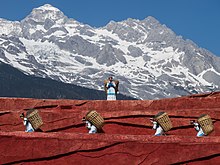Theatre of China
This article needs additional citations for verification. (April 2009) |

Theatre of China has a long and complex history. Today it is often called Chinese opera although this normally refers specifically to the more well-known forms such as Beijing Opera and Cantonese Opera, there have been many other forms of theatre in China.
Chinese Traditional form of theatre

Classical Chinese theatre
They are references to theatrical entertainments in China as early as the Shang Dynasty; they often involved happiness, mimes, and acrobatic displays.
The Tang Dynasty is sometimes known as "The Age of 1000 Entertainments". During this era, Ming Huang formed an acting school known as The Pear Garden to produce a form of drama that was primarily musical. That is why actors are commonly called "Children of the Pear Garden."
Shadow play
During the Dynasty of Empress Ling, shadow puppetry first emerged as a recognized form of theatre in China. There were two distinct forms of shadow puppetry, Pekingese (northern) and Cantonese (southern). The two styles were differentiated by the method of making the puppets and the positioning of the rods on the puppets, as opposed to the type of play performed by the puppets. Both styles generally performed plays depicting great adventure and fantasy, rarely was this very stylized form of theatre used for political propaganda. Cantonese shadow puppets were the larger of the two. They were built using thick leather which created more substantial shadows. Symbolic color was also very prevalent; a black face represented honesty, a red one bravery. The rods used to control Cantonese puppets were attached perpendicular to the puppets’ heads. Thus, they were not seen by the audience when the shadow was created. Pekingese puppets were more delicate and smaller. They were created out of thin, translucent leather (usually taken from the belly of a donkey). They were painted with vibrant paints, thus they cast a very colorful shadow. The thin rods which controlled their movements were attached to a leather collar at the neck of the puppet. The rods ran parallel to the bodies of the puppet then turned at a ninety degree angle to connect to the neck. While these rods were visible when the shadow was cast, they laid outside the shadow of the puppet; thus they did not interfere with the appearance of the figure. The rods attached at the necks to facilitate the use of multiple heads with one body. When the heads were not being used, they were stored in a muslin book or fabric lined box. The heads were always removed at night. This was in keeping with the old superstition that if left intact, the puppets would come to life at night. Some puppeteers went so far as to store the heads in one book and the bodies in another, to further reduce the possibility of reanimating puppets. Shadow puppetry is said to have reached its highest point of artistic development in the eleventh century before becoming a tool of the government.
Chinese opera
In the Song Dynasty, there were many popular plays involving acrobatics and music. These developed in the Yuan Dynasty into a more sophisticated form known as zaju, with a four- or five-act structure. Yuan drama spread across China and diversified into numerous regional forms, the best known of which is Beijing Opera[citation needed], which is still popular today.
Xiangsheng
Xiangsheng is a certain traditional Chinese comedic performance in the forms of monologue or dialogue.
See also
Further reading
Classical drama
- Faye Chunfang Fei. Chinese Theories of Theater and Performance from Confucius to the Present (University of Michigan Press, 2002). ISBN 0-472-08923-4.
- Shih Chung-wen. The Golden Age of Chinese Drama (Princeton University Press, 1976).
Shadow play
- Jacques Pimpaneau. Des poupées à l'ombre: le théâtre d'ombres et de poupées en Chine. Paris : Université Paris 7e, 1977.
Modern Chinese theatre
- Fong, Kuang-Yu and Kaplin, Stephen. "Theatre on a Tabletop: Puppetry for Small Spaces". Charlottesville, New Plays, Inc. 2003.
- Obraszow, Sergei. Theater in China. Berlin, Henschelverlag, 1963.
- Mackerras, Colin. The Chinese Theatre in Modern Times. From 1840 to the Present Day. London, Thames & Hudson, 1975.
- Zhao, Henry Y. H. Towards a Modern Zen Theatre: Gao Xingjian and Chinese Theatre Experimentalism. University of London: School of Oriental and African Studies, 2000.
- Chen, Xiaomei. Acting the Right Part. Honolulu, University of Hawaii Press, 2002.
- Riley, Jo. Chinese Theatre and the Actor in Performance. Cambridge, Cambridge University Press, 1997, ISBN 0-521-57090-5.
